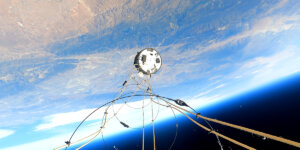
The USCRPL team prepare for the static fire. Image credit: Jason Goode
Based within the USC Department of Astronautical Engineering, USC Rocket Propulsion Lab (USCRPL) is the first and only student-led group to design, test, build and analyze a rocket that has reached space.
In 2018, USCRPL’s Graveler II broke the world record for the largest composite case static fire of a student-built and designed vehicle. The following year, the team’s Traveler IV launched out of Spaceport America in New Mexico – reaching an apogee of 339,800 feet, passing the Kármán line (the boundary between the Earth’s atmosphere and outer space) with a confidence of 90%.
And so it came to pass: USCRPL became the world’s first ever student team to launch a rocket into space.
Since then, USCRPL has gained a reputation as the USC Astronautics wunderkind – like so many that reach giddy heights early on, they’ve been striving to match and transcend their personal best.
View this post on Instagram
The onset of the Covid-19 pandemic threw a spanner in the works, but now – on the occasion of the successful Shockwave solid-rocket motor firing (the most powerful motor ever fired by a student group) – a four year effort to return to space is on the horizon. We caught up with student executive engineer Abbey Knoll to review past successes and discover what’s next for the premier student team.
What marks out USCRPL from other student rocket design teams?
RPL is unique in that we pride ourselves on making everything in-house. From the team goals, to budgeting, to every single part we integrate in the rocket, we provide students with the opportunity to solve real-world engineering problems by doing everything ourselves.
What challenges have you experienced in recent years?
Following the success of Traveler IV, USCRPL struggled due to the global pandemic. Without access to our lab space, or the opportunity for older members to transfer knowledge to the incoming members, a lot of generational knowledge was lost.
We then experienced more setbacks – but also gained important insights – when we exploded three motors in a row (Earthshaker 1, 2 and 3). As a result, we decided to scale down our designs to a less risky, smaller scale. This allowed us to reach a positive new phase with Firebiter and Fireball. We successfully static fired Firebiter in 2022, validating our motor, case and nozzle design. We flew these designs when Fireball launched on April 1, 2023, reaching an apogee of approximately 130,000 feet. The Fireball campaign was a turning point in our organization’s mission to get back to space.
What occurred during the recent Shockwave static fire, and why was this important?

Shockwave performs the successful static fire. Photo credit: Jason Goode
After flying Fireball last semester, we decided to scale up those designs to an 8 inch diameter motor – Shockwave! Shockwave was designed to have the most powerful motor ever fired by a student team, with the goal of breaking the record set by Graveler II back in 2018. On October 21,, 2023, Shockwave was successfully fired and reached a total impulse of 45,996 pound-force, surpassing Graveler II’s total impulse by about 4,400 pound-force. This means that all the components tested during the static fire are sufficient to withstand the pressure, temperature and thrust necessary for launching into space.
After four years of striving to create a motor more powerful than Graveler II, Shockwave is the outcome of learnings gathered by hundreds of USCRPL students. The static fire was the fundamental test that validated our motor, case and nozzle design for our upcoming spaceshot: Aftershock.
What are the team’s goals for the coming year? How do these goals align with wider industry priorities?
Following Shockwave’s success, the team will now attempt to return to space and break our own apogee record, currently held by Traveler IV. We are currently expecting Aftershock to reach an apogee of around 490,000 feet.
All in all – USCRPL was founded with the goal of becoming the first student team to send a rocket to space. But now we’ve set our sights even higher; we want to become the first student team to have a functioning space program that could eventually carry scientific payloads.
In the process of designing fully-functioning rockets, it goes without saying that students learn essential engineering skills that are highly sought after in industry – our challenges mirror those of the major corporations, space startups and national space agencies. So, when we graduate, we’re primed to tackle the most pressing problems. And in the meantime, we have plenty to keep us busy!
Click here to learn more about the Shockwave static fire and check the team’s Instagram for regular updates on lab-happenings, upcoming static fires and milestone launches.
Published on December 7th, 2023
Last updated on November 27th, 2024













